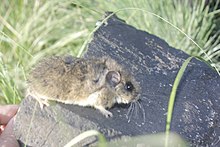| Mexican volcano mouse Temporal range: Pleistocene – Recent | |
|---|---|

| |
| Conservation status | |
 Least Concern (IUCN 3.1) | |
| Scientific classification | |
| Domain: | Eukaryota |
| Kingdom: | Animalia |
| Phylum: | Chordata |
| Class: | Mammalia |
| Order: | Rodentia |
| Family: | Cricetidae |
| Subfamily: | Neotominae |
| Genus: | Neotomodon Merriam, 1898 |
| Species: | N. alstoni |
| Binomial name | |
| Neotomodon alstoni Merriam, 1898 | |
The Mexican volcano mouse (Neotomodon alstoni) is a species of rodent in the family Cricetidae endemic to high elevation areas of the Trans-Mexican Volcanic Belt.
Taxonomy and systematics
Merriam originally described the Mexican volcano mouse as one of three species in the genus Neotomodon; N. alstoni was moved to the deer mouse genus Peromyscus in 1979, then subsequently moved back to Neotomodon. Merriam does not state after whom the species is named in his original description for the genus (and species). Despite the current taxonomy, a recent phylogeny based on cytochrome-b sequences shows Peromyscus to be polyphyletic, and the authors of that paper suggest Neotomodon (and several other monotypic genera) be transferred to Peromyscus.
Distribution
The Volcano mouse is seen to reside restrictively to higher elevation or boreal habitats of the trans-volcanic belt of Central Mexico. There has been no discovery of the fossil record for this species but it seems to have a similarity in appearance to Pliotomodon' fossil. The mouse can perform simple burrowing in well-drained areas and sometimes pass under boulders.
Characteristics
The Volcano mouse has a relatively medium-sized compared to other members of its genus. It has a pair of broad, naked ears while its fur is rather soft with grayish to fulvous brown color dorsally and whitish ventrally. Its tail is quite short but sharply bicolored. Compared to its short brain case entrapped in a broad skull, its zygomatic expanded. Its molars are pretty large and densely enameled. No sexual dimorphism in this species.
With relatively large eyes and ears, bi-colored body and tail (dark dorsally and white ventrally), and a tail slightly shorter than the body length, the Mexican volcano mouse appears very similar to a deer mouse, but it is diagnosed by several skull characters including the number and extent of palatal ridges and molar characteristics.
Life events
Mexican volcano mouse breeding is thought to occur between June and September, with two to three litters per year of 3.3 young per litter. The mouse exhibits bi-parental care in captivity, which suggests a monogamous mating system. Little is known about other life history characteristics of the species, for example, sex ratio, age at first breeding, etc. Male with high testosterone levels develop a paternal care which increases better chances of survival and growth of its offspring. This is put under study by captive pair of mouse during postpartum and weaning periods. The presence of male lead to females care less for the young. When both parents present, however, their offspring survival chance increases significantly.
References
- Álvarez-Castañeda, S.T.; Castro-Arellano, I. (2016). "Neotomodon alstoni". IUCN Red List of Threatened Species. 2016: e.T14600A22345400. doi:10.2305/IUCN.UK.2016-2.RLTS.T14600A22345400.en. Retrieved 17 November 2021.
- Williams, S. L.; J. Ramirez-Pulido & R. J. Baker (1985). "Mammalian Species: Peromyscus alstoni" (PDF). 242: 1–6.
{{cite journal}}: Cite journal requires|journal=(help) - Merriam C. H. (1898). "A new genus (Neotomodon) and three new species of murine rodents from the mountains of southern Mexico". Proceedings of the Biological Society of Washington. 12: 127–129.
- ^ Bradley, Robert D.; Nevin D. Durish; Duke S. Rogers; Jacqueline R. Miller; Mark D. Engstrom & C. William Kilpatrick (2007). "Toward a Molecular Phylogeny for Peromyscus: Evidence from Mitochondrial Cytochrome-b Sequences". Journal of Mammalogy. 88 (5): 1146–1159. doi:10.1644/06-MAMM-A-342R.1. PMC 2778318. PMID 19924266.
- ^ Williams, Stephen; Ramirez-Pulido, Jose; Baker, Robert. "Peromyscus alstoni" (PDF). Mammalian Species. Virginia Hayssen.
- Luis, J.; A. Carmona; J. Delgado; F. A. Cervantes & R. Cardenas (2000). "Parental behavior of the volcano mouse, Neotomodon alstoni (Rodentia: Muridae), in captivity". Journal of Mammalogy. 81 (2): 600–605. doi:10.1644/1545-1542(2000)081<0600:PBOTVM>2.0.CO;2.
- J, Luis; L, Ramirez (2009). "Paternal behavior and testosterone plasma levels in the Volcano Mouse Neotomodon alstoni (Rodentia: Muridae)". Rev Biol Trop. 57 (1–2): 433–9. PMID 19637720.
- Luis, Juana; Cervantes, Fernando. "Male Influence on Maternal Behavior and Offspring of Captive Volcano Mice (Neotomodon alstoni) from Mexico". Journal of Mammalogy. Archived from the original on 18 November 2016. Retrieved 12 November 2016.
Further reading
- Musser, G. G. and M. D. Carleton. 2005. Superfamily Muroidea. pp. 894–1531 in Mammal Species of the World a Taxonomic and Geographic Reference. D. E. Wilson and D. M. Reeder eds. Johns Hopkins University Press, Baltimore.
| Myomorpha | |||||||||||||||||||||||||||||||||||||||||||||||||||||||||||||||||||||||||||||||||||||||||||||||||||||||||||||||||||||||||||||||||||||||||||||||||||
|---|---|---|---|---|---|---|---|---|---|---|---|---|---|---|---|---|---|---|---|---|---|---|---|---|---|---|---|---|---|---|---|---|---|---|---|---|---|---|---|---|---|---|---|---|---|---|---|---|---|---|---|---|---|---|---|---|---|---|---|---|---|---|---|---|---|---|---|---|---|---|---|---|---|---|---|---|---|---|---|---|---|---|---|---|---|---|---|---|---|---|---|---|---|---|---|---|---|---|---|---|---|---|---|---|---|---|---|---|---|---|---|---|---|---|---|---|---|---|---|---|---|---|---|---|---|---|---|---|---|---|---|---|---|---|---|---|---|---|---|---|---|---|---|---|---|---|---|
| |||||||||||||||||||||||||||||||||||||||||||||||||||||||||||||||||||||||||||||||||||||||||||||||||||||||||||||||||||||||||||||||||||||||||||||||||||
| |||||||||||||||||||||||||||||||||||||||||||||||||||||||||||||||||||||||||||||||||||||||||||||||||||||||||||||||||||||||||||||||||||||||||||||||||||
| Taxon identifiers | |
|---|---|
| Neotomodon alstoni | |







